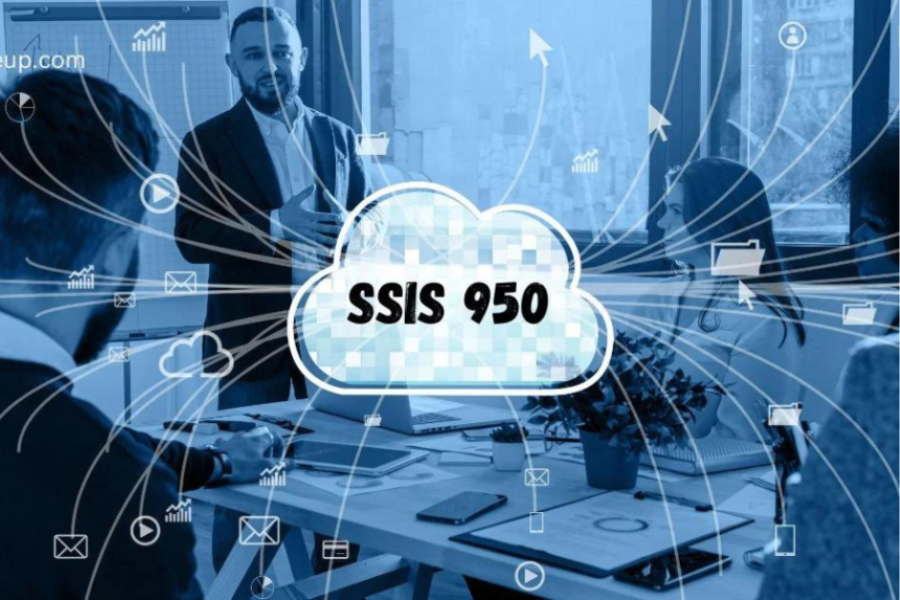A Comprehensive Guide to SSIS-950: Unlocking New Possibilities in Data Integration
Introduction
In today’s digital age, data drives decisions, fuels innovations, and shapes business strategies. Effective data management and integration are crucial for companies to stay competitive, optimize operations, and make informed decisions. SQL Server Integration Services (SSIS), a powerful tool from Microsoft, has long been a cornerstone for enterprises managing data workflows. The latest evolution in this tool, SSIS-950, takes data integration to new heights by offering advanced features tailored for modern data environments.
SSIS-950 enhances traditional ETL (Extract, Transform, Load) processes and introduces next-level capabilities, such as real-time data integration, improved scalability, and seamless support for cloud-based environments. For businesses seeking efficient, reliable, and scalable data management, SSIS-950 represents a game-changing solution. This comprehensive guide explores SSIS-950’s key features, benefits, real-world use cases, and how it can be leveraged for success in 2024 and beyond.
What Makes SSIS-950 Different?
While SSIS has been a trusted tool for data integration, SSIS-950 sets itself apart by evolving to meet the demands of modern business operations. The tool provides enhanced performance, particularly when dealing with large datasets and complex systems, and adds important features designed to work seamlessly with cloud environments. Here are the key distinctions that make SSIS-950 a next-gen solution:
- Cloud Integration Support: As cloud adoption accelerates, SSIS-950 includes robust features to connect, migrate, and manage data across hybrid environments—whether on-premises or in the cloud. Its deep integration with Azure ensures smoother transitions and more efficient workflows in cloud-based architectures.
- Real-Time Data Processing: One of the standout features of SSIS-950 is its ability to perform near real-time data transfers. This feature is especially crucial for industries that need up-to-the-minute information for faster decision-making. SSIS-950 helps organizations integrate live data seamlessly, reducing delays in data updates.
- Advanced Data Transformation Tools: SSIS-950 boasts a wide array of advanced data transformation capabilities. From data cleansing and format conversions to aggregations and error handling, these tools streamline even the most complex workflows. These capabilities allow businesses to ensure data quality and meet diverse operational needs.
- Improved Scalability and Performance: As businesses increasingly deal with vast amounts of data, scalability becomes paramount. SSIS-950 includes memory optimizations, multi-threading, and enhanced parallel processing capabilities, which allow it to handle large volumes of data efficiently without compromising on speed or performance.
- Error Handling and Debugging: SSIS-950 offers more sophisticated error-handling and debugging features, making it easier to identify and resolve issues during the ETL process. This reduces downtime and helps ensure that data flows smoothly from source to destination.
- Support for Multiple Data Sources: One of SSIS-950’s greatest strengths is its ability to connect to a wide variety of data sources. Whether you’re dealing with relational databases, flat files, cloud services, or APIs, SSIS-950 can integrate data from almost any source, allowing for greater flexibility and versatility in data integration tasks.
Key Features of SSIS-950
SSIS-950 is a robust tool with a wide range of features designed to simplify data integration and ensure high-quality, reliable data processing. Some of its key features include:
1. Cloud Integration Support
SSIS-950 offers seamless integration with Azure, the cloud platform offered by Microsoft, and supports a variety of other cloud providers. This enhanced cloud capability allows organizations to move and manage data across cloud-based systems with ease. Whether migrating data from legacy on-premises systems to the cloud or managing hybrid data environments, SSIS-950 ensures smooth data flow between various platforms.
2. Real-Time Data Processing
Unlike earlier versions of SSIS, which were primarily batch-based, SSIS-950 supports real-time data processing. This is crucial for businesses that require up-to-date information for decision-making. For example, e-commerce platforms can benefit from real-time data feeds on inventory levels, sales, and customer activities, enabling them to make immediate adjustments to marketing and sales strategies.
3. Advanced Data Transformation Tools
SSIS-950 includes a suite of advanced data transformation tools, designed to simplify complex processes like data cleansing, aggregation, and conversion. The tool supports a wide variety of data formats, which makes it easier to prepare data for reporting, analytics, and storage. Whether it’s formatting customer information or performing intricate calculations, SSIS-950 makes transforming data more efficient and effective.
4. Improved Scalability
With businesses generating and handling more data than ever before, scalability has become a key requirement. SSIS-950 enhances the scalability of data workflows by leveraging multi-threading, parallel processing, and optimized memory management. These features ensure that large datasets can be processed faster without overwhelming system resources, making SSIS-950 ideal for enterprise-scale operations.
5. Error Handling and Debugging
The improved error-handling and debugging tools in SSIS-950 are a significant upgrade over previous versions. The tool allows developers to easily identify where issues arise in the ETL process, monitor error logs in real-time, and implement corrective measures swiftly. This minimizes the risk of data inconsistencies and failures, ensuring smooth and reliable operations.
6. Support for a Wide Range of Data Sources
Whether it’s a relational database, a flat file, a web service, or a third-party API, SSIS-950 can connect to virtually any data source. This versatility makes SSIS-950 an ideal solution for businesses that rely on diverse data sources or need to integrate data from various platforms, including legacy systems, cloud databases, and modern SaaS applications.
Benefits of Using SSIS-950
By adopting SSIS-950, organizations can realize a wide array of benefits, both in terms of operational efficiency and business outcomes.
1. Streamlined Data Processes
One of the key advantages of SSIS-950 is its ability to simplify complex data workflows. By automating ETL tasks and streamlining data transformations, SSIS-950 helps businesses reduce the time and effort required to move and manipulate data. This results in quicker data processing and more efficient operations.
2. Cost Efficiency
With SSIS-950, organizations can automate repetitive tasks and reduce manual interventions, leading to lower labor costs. Additionally, the tool’s ability to optimize performance helps reduce infrastructure and operational costs associated with managing large-scale data workflows.
3. Improved Data Quality
SSIS-950’s data cleansing and standardization features ensure that only accurate, clean data enters your systems. By filtering out incomplete or erroneous data, businesses can enhance the quality of their reporting and analysis, improving decision-making and reducing the risk of costly mistakes.
4. Enhanced Decision-Making
With the ability to process data in real-time, SSIS-950 enables decision-makers to access the most up-to-date and accurate information available. This is especially valuable in industries like finance, healthcare, and e-commerce, where timely data is essential for making informed decisions quickly.
5. Reduced Risk of Data Errors
Robust error-handling capabilities minimize the chances of data inconsistencies or failures. With SSIS-950, businesses can quickly identify issues in their data pipelines and resolve them before they affect operations, ensuring greater reliability and trust in the data.
6. Faster Deployment
Pre-built connectors, templates, and drag-and-drop functionality make it easier to deploy SSIS-950 solutions with minimal coding. This reduces development time and enables faster project delivery, helping organizations meet their deadlines without sacrificing quality.
Use Cases: Where SSIS-950 Shines
SSIS-950 is a versatile tool that can be applied in a variety of industries and use cases. Here are a few areas where it excels:
1. E-Commerce Data Integration
In e-commerce, SSIS-950 can be used to integrate various data sources, such as customer transactions, inventory systems, and sales platforms. With real-time data processing capabilities, businesses can synchronize information from multiple channels and ensure customers receive up-to-date product availability, order status, and personalized recommendations.
2. Financial Data Consolidation
For financial institutions or departments, SSIS-950 can consolidate data from disparate systems, such as accounting software, banks, and third-party financial services. With SSIS-950’s advanced transformation and error-handling features, businesses can ensure accurate financial reporting and analytics across various platforms.
3. Healthcare Data Management
In healthcare, SSIS-950 can integrate data from patient records, lab results, insurance information, and other medical sources. By consolidating this data in real-time, healthcare organizations can ensure accurate, timely information for patient care, billing, and regulatory reporting.
4. Business Intelligence (BI) and Analytics
SSIS-950 is an ideal tool for feeding business intelligence (BI) systems with accurate, up-to-date data from various sources. Its real-time processing capabilities ensure that insights are based on the latest available information, empowering organizations to make data-driven decisions.
5. Cloud Migration Projects
As more businesses migrate to the cloud, SSIS-950 simplifies the process of transferring large datasets from legacy on-premises systems to modern cloud environments. Whether moving to Azure or another cloud provider, SSIS-950 ensures a smooth transition with minimal disruption to business operations.
Getting Started: Tips and Best Practices
To ensure success with SSIS-950, consider the following best practices:
1. Plan Your Data Flow
Before diving into development, carefully map out your data sources, destinations, and transformations. Proper planning ensures a smoother integration process and helps avoid errors down the line.
2. Use Pre-Built Components
SSIS-950 comes with a variety of pre-built connectors and templates. Leverage these tools to save time and minimize the potential for mistakes.
3. Monitor and Optimize Performance
Regularly monitor your data pipelines to identify potential bottlenecks and areas for optimization. Continuously improve the performance of your SSIS workflows by fine-tuning memory settings and processing capabilities.
4. Implement Strong Security Protocols
Ensure that sensitive data is protected by implementing encryption and access controls. SSIS-950 provides tools to safeguard data as it moves between systems.
5. Leverage Training Resources
Microsoft offers comprehensive documentation and training for SSIS. Familiarizing yourself with these resources will help you maximize the potential of the tool and optimize your data integration processes.
Future Outlook for SSIS-950
As the need for data-driven decision-making continues to grow, SSIS-950 will remain a critical tool for businesses looking to streamline their data integration processes. Microsoft is expected to continue enhancing SSIS-950, especially as cloud-first strategies and AI-driven analytics become more prevalent. As data volumes and complexity increase, SSIS-950 will be there to help businesses keep pace with the demands of the digital age.
Conclusion
SSIS-950 is a powerful, flexible, and scalable data integration solution that can unlock new possibilities for businesses of all sizes. Whether you’re involved in e-commerce, finance, healthcare, or business intelligence, SSIS-950’s advanced features can simplify data workflows, improve data quality, and enable faster, more informed decision-making. By adopting SSIS-950, businesses can position themselves for success in an increasingly data-driven world.
Stay in touch to get more news & updates on info discovers.






